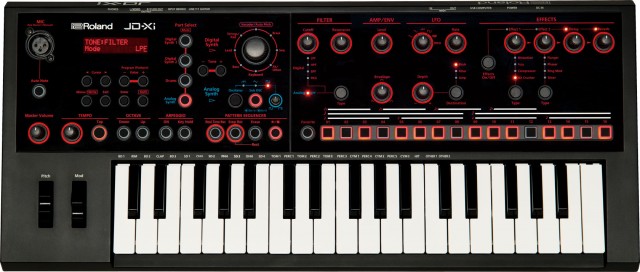
In this video, Mark Watson of Roland Australia takes a look at getting started with the new Roland JD-Xi hybrid analog + digital synthesizer:
The video looks at how to create your own tones, save them in a program and how to create tracks using the JD-Xi’s four-track pattern sequencer.
The Roland JD-Xi has a street price of about US $500. See the Roland site for details.

Mark Watson does the best vids for the jd xi
He makes me actually want one! He even makes me like Flangers! These videos are perfection, I like the Simple illustrations of the envelopes and Lfo too, it makes the fast flow of quite complex things easy to follow.
Also I note Roland have released a red version of this synth for some stores.
He needs to do the JD XA.
And the new Boutique range. Hello Roland, are you listening!?
laughable unfinished product imo. no song mode?? gimme a break! so how do you put a song together? the electribes have at least an event recorder.
Does ANY mini synth have a Song mode?
I find it bizarre that, half the people complain that these mini synths are way too small, and the other half wants companies to stuff in more features.
I’ve only tried a few of these – the microKorg, the mini nova and the microBrute. But the one that’s the most fun to use, by far, is also the one that does the least – the microBrute.
And it’s not because it’s an analog synth vs a digital synth. It’s because it’s got a straightforward front panel that’s fun to use.
There’s a tendency for digital synth designers to add one more feature – because they can. So you get a set of four control knobs that have eight different functions and then you have to go through a matrix to figure out WTF is what.
Just say no to feature creep on synths. Make them sound good and make them fun to use.
That’s the thing – this is a mini synth that competes with the Microkorgs and the Mini Nova. When you look at the feature sets, there is no comparison, even though the other instruments still sound good. Polyphony, sequencing, drums and a REAL analogue voice. To me the only drag is that there is no way to layer sounds from the keyboard afaik.
One other thing – this is the only mini synth that you can make a full beat on unless we include the Microstation. It’s also an audio interface, so you can export your beat directly into a DAW while maintaining a high quality signal path. This thing does a LOT for the money.
Admin: Personal attack deleted. Keep comments on topic and constructive.
There’s no doubt that this is the most powerful mini synth ever made. The VP330 mode and the auto note option are esp cool, and this has four times the voices as other mini synths.
It looks just as complicated to use, though, as the microkorg, which is ugly to program. The microBrute and the Reface synths have no menus and all the controls are right there, which makes them feel more like instruments than miniaturized workstation keyboards.
I would like this better if it was less menu oriented, had a few less complications and if it had support for splits and layers.
Also – let’s hear something besides EDM demos next time!
Still – it’s an impressive little thing that I may have to give a try.
I am Song Mode.
WTF no RAVE Button!?!
Great video, quite a few features I wasn’t aware of. Some interesting ideas from Roland to make this synth super easy to use and accessible to beginners and non-musicians, I’m not aware of any other synth in this price range that has auto-note forexample! Fun take on a single-knob envelope. I like that you can add effects to the analog sound, but you’re then back in the digital domain.
Auto-note could be absolutely killer for jazz or improvising over a set of chords.
(I like the “idiom” presets :D)